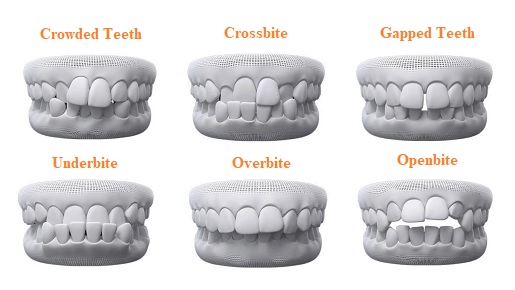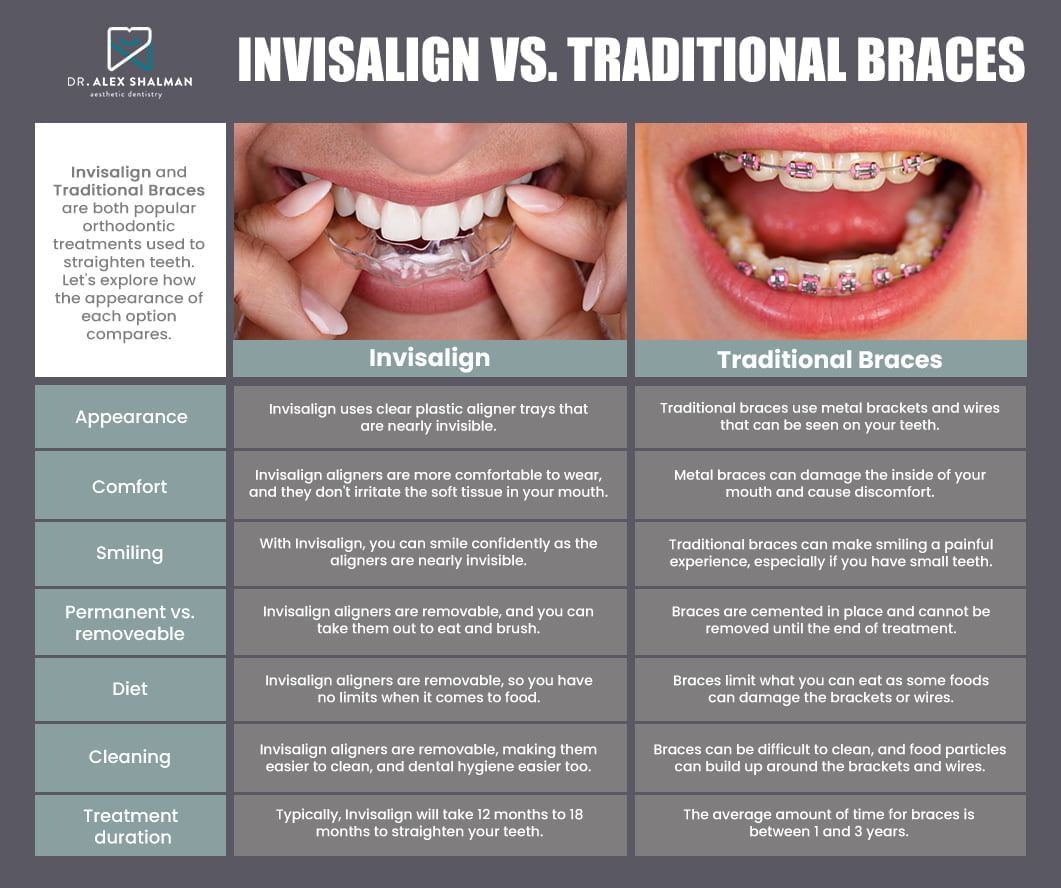Success Stories: How Invisalign Changed Lives and Boosted Confidence
Success Stories: How Invisalign Changed Lives and Boosted Confidence
Blog Article
Invisalign vs. Conventional Braces: Which Alternative Is Right for You?
When considering orthodontic treatment, the selection in between Invisalign and conventional braces presents numerous important variables that warrant careful evaluation. Invisalign uses a discreet alternative with removable aligners, while traditional braces give an extra noticeable yet effective option for extreme misalignment.
Introduction of Therapy Alternatives

In contrast, standard dental braces are composed of steel brackets and cables that are bound to the teeth. This technique applies continuous stress gradually to achieve alignment. While efficient for complex orthodontic problems, typical dental braces call for normal sees for changes and can posture challenges in keeping oral health as a result of the trouble of cleansing about cords and braces.
Both options have their qualities, and the option typically pivots on particular dental conditions, lifestyle preferences, and individual conformity. Eventually, consulting an orthodontic specialist is vital for figuring out one of the most suitable treatment strategy tailored to individual demands. Understanding the nuances of each option can substantially affect the total success of orthodontic treatment.
Aesthetic Factors To Consider
A considerable factor affecting the option in between Invisalign and typical braces is the visual charm each treatment supplies. Invisalign aligners are crafted from clear plastic, making them practically unseen when used. This discreet appearance is specifically appealing to teenagers and grownups who may really feel uncomfortable concerning their orthodontic therapy. The capability to preserve a natural smile throughout the placement procedure can considerably improve the client's self-confidence in professional and social setups.
In contrast, traditional braces contain steel brackets and wires, which can be a lot more recognizable. While advancements in orthodontic technology have caused the advancement of smaller brackets and tinted elastics, traditional dental braces still preserve an even more obvious account. For some individuals, the presence of braces might prevent them from seeking essential therapy.
Eventually, the choice in between Invisalign and typical dental braces might depend upon individual choices concerning aesthetic appeals. Clients who prioritize discernment typically lean towards Invisalign, while those who are less concerned regarding visibility may opt for conventional dental braces. Comprehending the visual ramifications of each choice is essential for making a notified choice that lines up with one's way of living and preferences.
Convenience and Convenience

In terms of benefit, Invisalign aligners are detachable, allowing clients to appreciate their preferred foods without constraint and preserve optimal oral health. Brushing and flossing are simplified, as the aligners can be obtained throughout these regimens, whereas conventional see braces need mindful maneuvering around wires and brackets.
In comparison, typical dental braces require normal adjustments, making them less convenient for those with hectic routines. Overall, the convenience and convenience of Invisalign make it an enticing selection for several people looking for orthodontic treatment.
Treatment Duration and Efficiency
While both Invisalign and conventional dental braces are reliable in fixing oral misalignments, the duration of therapy can vary significantly between both alternatives. Normally, Invisalign treatment can take anywhere from 12 to 18 months, depending on the complexity of the situation. The clear aligners work by gradually moving teeth right into their wanted settings, and routine follow-ups with an orthodontist help make certain development stays on course.
On the other hand, typical dental braces frequently need a longer dedication, usually ranging from 18 months to three years. This is due to their fixed nature and using brackets and wires, which can be much more reliable for complex situations and serious imbalances (Invisalign). The treatment effectiveness of traditional dental braces is well-documented, as they permit precise adjustments and better control over tooth movement
Ultimately, the selection in between Invisalign and standard dental braces may pivot on both the expected treatment duration Homepage and the certain dental concerns handy. Consulting with an orthodontist is crucial, as they can give customized referrals based on individual needs, making sure the picked technique lines up with desired durations and end results.
Price Comparison and Insurance Choices
Expense plays a considerable role in the decision-making procedure for individuals thinking about orthodontic treatment, whether selecting Invisalign or typical dental braces. Usually, the cost of Invisalign ranges from $3,000 to $8,000, while traditional braces usually cost in between $2,000 and $6,000. Aspects influencing these prices include the intricacy of the instance, the period of treatment, and geographical area.
Lots of oral insurance strategies offer partial insurance coverage for orthodontic treatments, however the specifics can vary commonly. Usually, typical dental braces may be much more regularly covered by insurance strategies contrasted to Invisalign, which some insurance providers categorize as a cosmetic treatment.
In addition, several orthodontic methods use adaptable settlement strategies, making both treatment choices much more obtainable. Individuals should make inquiries about potential financing choices and price cuts for ahead of time payments. Reviewing the complete price, including insurance policy advantages and layaway plan, is essential for making a notified choice that straightens with both visual choices and budget factors to consider.

Verdict
In summary, the option between Invisalign and conventional braces rests on several factors, consisting of visual choices, comfort, treatment period, and price. Invisalign uses a very discreet, removable alternative that facilitates dental health and dietary versatility, while typical braces might be better for complex oral concerns and typically come with a lower cost factor. Ultimately, appointment with an orthodontist is important Continue to assess individual conditions and figure out the most ideal therapy choice for achieving optimal oral positioning.
When considering orthodontic therapy, the selection between Invisalign and traditional braces provides a number of crucial aspects that warrant mindful evaluation.Comparing Invisalign and traditional braces reveals distinctive therapy alternatives for orthodontic correction.While both Invisalign and standard braces are reliable in correcting dental imbalances, the period of treatment can differ substantially between the two choices.Price plays a considerable duty in the decision-making process for people taking into consideration orthodontic therapy, whether opting for Invisalign or standard dental braces.In recap, the option in between Invisalign and standard braces pivots on numerous variables, including aesthetic preferences, convenience, therapy duration, and price.
Report this page